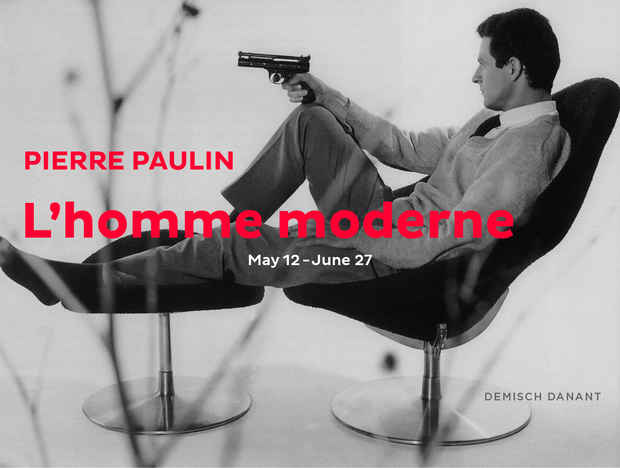Pierre Paulin “L’Homme Moderne”
Demisch Danant

This event has ended.
Demisch Danant presents Pierre Paulin: L’Homme Moderne a celebration of the prolific career of one of the most admired European designers of the 20th century. Opening May 12, 2015, the exhibition surveys Paulin’s breakthroughs of the 1960s through early 1980s, and will showcase designs commissioned by the Mobilier National of France in a living environment inspired by Paulin’s unique architecture. Featuring more than twenty exceptional works, including many never before exhibited publicly, L’Homme Moderne will provide a fresh look at Paul’s full vision and contributions to modern design beyond the confines of Pop-inflected pieces for which he has until now been best known.
L’Homme Moderne will be on view through June 27th, and precedes a major Pierre Paulin retrospective opening at the Centres Georges Pompidou in Paris in October 2015.
At Demisch Danant, Pierre Paulin’s furniture and lighting will be presented under a dramatic stretched jersey tent structure inspired by the Meubles et Fonction Paris showroom designed by Paulin in 1970. This setting references Paulin’s pioneering use of fabric in architecture and industrial design, exploiting textiles to redefine planes or alter space. Paulin was a master at seating design and his use of fabric revolutionized the field. Reacting to the rigid forms of the 1950s, he challenged the potentials of seating by creating entirely upholstered designs that effectively concealed their structure and engineering. This radical innovation introduced fluid, soft forms to furniture design and heralded the spirit of a new era.
L’Homme Moderne includes several examples of Paulin’s signature techniques, including different models of the Mushroom series manufactured by Artifort (1960); the iconic Ribbon Chair (1965), a collaboration between Paulin and textile designer Jack Lenor Larsen; and the Dos a Dos (1968), originally commissioned by the Mobilier National and a rare model with limited production. These designs exhibit soft, organic, curved forms that mask the inner supports that define the functionality of design.
In 1970, Paulin was commissioned by the Mobilier National to design George Pompidou’s private Presidential Apartment in the Palais de l’Élysée– one of the most significant design assignments of the decade. Paulin created a series of objects– seating, tables and lighting– for the residence. He draped the building’s interior in stretch jersey, effectively altering the existing architecture via the same technique he applied to his furniture. The exhibition presents iconic works from the Élysée series, including a dining set and an extremely rare example of the smoked plexiglass bookcase created for the smoking room.
In contrast to his iconic soft forms, Paulin also produced works that reveal and even celebrate the complexity of the structure of his designs. The Spider Chair (1965) bears a rigid geometric lacquered wood base and unveils the web-like rope structure that supports the upholstered seat.
In 1983, Paulin was again commissioned by the government – this time to furnish the offices of President Francois Mitterrand. The early 1980s pieces on view in L’Homme Moderne reveal Paulin’s interest in modernizing more traditional forms, and his return to a more classical practice of furniture making.
Pierre Paulin’s measured play with structure and form have defined his legacy as an enduring figure in the history of design.
Pierre Paulin (1927-2009) was born in Paris to a French father and German-Swiss mother. Paulin began his career working in the studio of Marcel Gascoin, whose dedication to functional, mass-produced designs strongly resonated with Paulin’s developing interest in Scandinavian furniture and its emphasis on the social component of modern design. Paulin’s connection to his German ancestry accentuated his interest in production furniture and he was greatly influenced by American counterparts such as George Nelson and Charles Eames. In 1959, Paulin began a partnership with the Dutch manufacturer Artifort that lasted through the mid-1970s. He is perhaps best known for the innovative designs he produced for Artifort in the 1960s, which are today considered some of the most significant designs of the decade. Paulin’s prolific career included industrial design, furniture, interior design, and he received some of the most significant commissions of his era. Most notably, he was commissioned by the Mobilier National to design the private apartments of President George Pompidou at the Palais de l’Élysee in 1970, and to furnish the office of President François Mitterand in 1983. Pierre Paulin’s work can be found in the collections of major international museums, including the Museum of Modern Art in New York, the Musée des Arts Décoratifs in Paris and London’s Victoria and Albert Museum. A major retrospective will be opening at the Centre Pompidou in Paris in October 2015.
Media
Schedule
from May 12, 2015 to June 27, 2015
Opening Reception on 2015-05-11 from 18:00 to 20:00